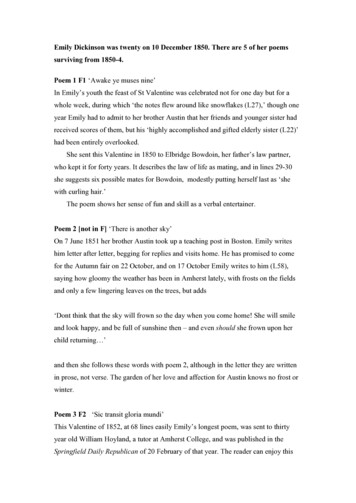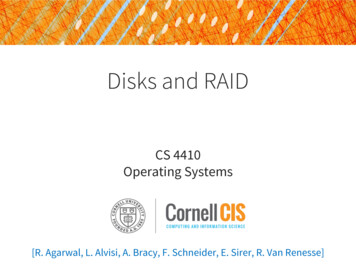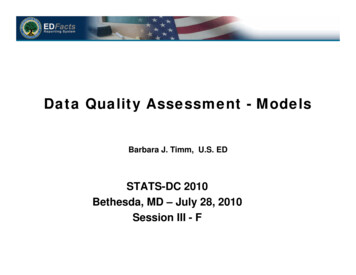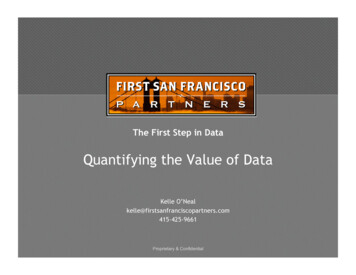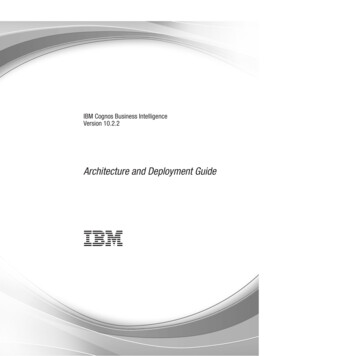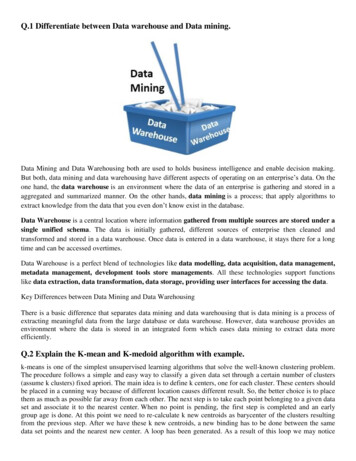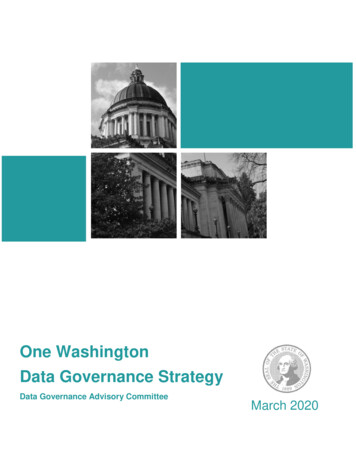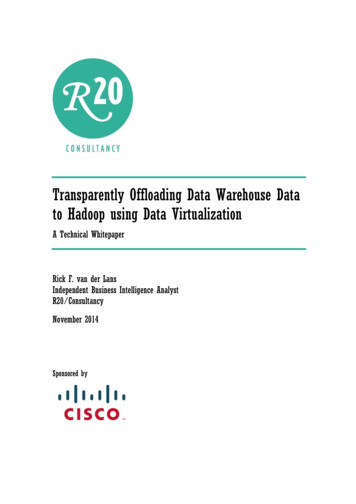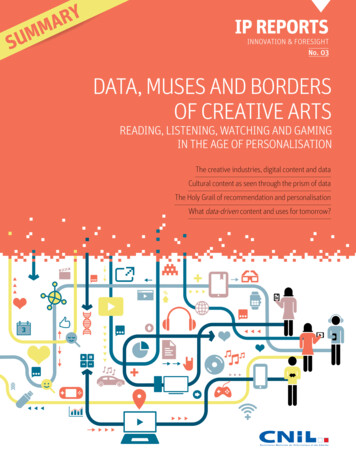
Transcription
YRAMSUMIP REPORTSINNOVATION & FORESIGHTNo. 03DATA, MUSES AND BORDERSOF CREATIVE ARTSREADING, LISTENING, WATCHING AND GAMINGIN THE AGE OF PERSONALISATIONThe creative industries, digital content and dataCultural content as seen through the prism of dataThe Holy Grail of recommendation and personalisationWhat data-driven content and uses for tomorrow?3
EDITORIALOpinion polls regularly remind us that cultural practices take up a large portionof French people's daily life. And yet these surveys are missing somethingessential. They fail to show us the vital role played by culture in our individualand collective lives.Reading a book, listening to music, watching films and TV shows - as well asplaying video games, no doubt - over and above their entertainment value, are probably themost suitable spheres for the development and permanent remodelling of our identity. It seemsto me that the imaginary space they open up to us is a laboratory, a workshop in which wecan compare what we think we are with other possible lives; where we can imagine ourselveswith other ways of thinking, feeling, loving or, in short, living out our lives. In other words,it is through our contact with artistic content that we constantly invent and understand theparents, friends, citizens, heroes and lovers that we are or aspire to be.Replicated and distributed on a massive scale for industrial and economic reasons, artisticworks are at the same time the canvasses on which shared feelings and beliefs can be playedout: they lie at the crossroads of the most collective and the most intimate, at the centreof our public and personal destinies. Being at the forefront of the digital revolution that isradically changing every facet of our societies one by one, CNIL could hardly avoid questioningthe impacts of data on the creation and distribution of cultural content - focal points of ouridentity construction.The changes on this front are indeed spectacular and as elsewhere, our new practices andconsumption patterns are starting to produce personal data. Data feeds personalisation andrecommendation algorithms. These algorithms are increasingly indispensable companionsto find our way in huge content catalogues. They can foster discovery and diversity, or just aseasily lock people into stereotyped tastes or very limited horizons and “filter bubbles”. The riskis that the creation and consumption of artistic work will be watered down to such an extentthat it no longer gives us an opportunity to encounter "otherness" and different imaginaryuniverses, becoming instead the stage for a pale, endlessly repeated monologue.Any debate about the value people derive from the use of their personal data should notbe confined to the mere fact that the service is free of charge for the user. On the contrary,it should consider what gives cultural consumption its irreplaceable value: namely, that itbroadens the field of what is possible and what is conceivable or thinkable.In the face of these trends, citizens seem to have lost their voice. There is little or no debate:the collection of personal data seems to have become the "necessary evil" for accessing certaininnovative digital services. But can we resign ourselves to such a prospect?02CNILIP REPORTS - DATA, MUSES AND BORDERS OF CREATIVE ARTS
Shouldn't we be developing a culture of data that puts us all back at the centre of the digitallandscape, and gives data an identity that is more than its mere economic value?And yet in this sector, by enabling personalisation, data also makes services more useful - maybeeven more empathetic. The cultural industries were among the first to be dematerialised; theyare something of a testing ground because they have built hybrid business models. It givesus an opportunity to move beyond the over-simplistic stalemate that opposes protection ofrights and innovation. Instead of burying the protection of personal data in general terms andconditions that are all too often imprecise and difficult to understand, we should be makingit the cornerstone of a relationship of trust with users. Do advanced features require accessto the person's location? To the person's movements? To the person's speed of travel? To thevarious sensors in the person's telephone or connected devices? And tomorrow, to the person'semotions and moods? Why not. but to what end? How? What framework would this require?What limitations should we impose? And most importantly, how can we guarantee that theuser will not be passively analysed, supposedly "for his own good"? How can we make surethe user does in fact consent to his data being used for these optional services? How can wedemonstrate that these optional features are not just excuses for collecting data that in factwill only ever be needed for sales or advertising purposes?This IP Report No. 3 aims to fuel debate on the intensive use of personal data by recommendationand personalisation tools, which play a key role today in the consumer market for digitalcultural content. It is also a call for economic stakeholders in this sector - and all other sectors- to innovate and show that businesses, which claim to be focusing on the user experience, arealso ready to take up the challenge of ethics and trust. Most importantly, it wants the culturalvanguard (both commercial and non-commercial) to take up the subject and invent the digitalworld of tomorrow.CONTENTSIsabelle FALQUE-PIERROTIN,CNIL ChairPart 0.1Part 0.2THE CREATIVEINDUSTRIES,DIGITAL CONTENTAND DATACULTURAL CONTENTAS SEEN THROUGHTHE PRISMOF DATAPart 0.3Part 0.4THE HOLY GRAILOF RECOMMENDATIONAND PERSONALISATIONWHAT DATA-DRIVENCONTENT AND USESFOR TOMORROW?03
Part 0.1THE CREATIVE INDUSTRIES,DIGITAL CONTENTAND DATA4 SECTORSIN THE SPOTLIGHTTIME SPENT PER WEEK ON CULTURAL AND CREATIVE ACTIVITIESBY FRENCH PEOPLE AGED 10 AND OVER(2012 by comparison with 2011)22 hrs 21 min/week3 hrs 11 min/dayWatch TVPlay video gamesListen to radioListen to musicother than on radioEbooksRead booksWatch videos12 hrs 17 min/week1 hr 45 min/day (1 hr 45 min more than in 2011)10 hrs 59 min/week1 hr 34 min/day (25 min less than in 2011)6 hrs 10 min/week53 min/day5 hrs 27 min/week47 min/day (21 min less than in 2011)4 hrs 12 min/week36 min/daySource: GfK - 2012 survey of 2,305 respondents/ EY, Panorama des Industries Créativeset Culturelles en France, November 2013.Video and"animated images"content, more specificallyvideo on demandand catch-up TVMusic(creation, production,distribution, listeningto recorded musicand the emergingmarket for streaming music)Video games(PC games,console games,mobile games,and social network games)04CNILDIGITAL CONTENTAND NEW CULTURALPRACTICESDigital content is everywhere in oureveryday lives. Today it accounts foraround 40% of the cultural industry'srevenue, as against only 17% in 2010. It is expected to reach 63% in 2018.Roughly one-third of the French people whouse a streaming music service have a paid subscription (source: Médiamétrie CNIL, 2015).In France, streaming is gaining ground andalready generating revenue on a par with musicdownloads (source: SNEP). The same trend canbe seen worldwide, where streaming representsover one-quarter of digital music revenues.End-2014, roughly one-third of French onlineusers had already watched a video on demand(source: Médiamétrie)28 million French people play video games(source: EY/CNC)11% of French people over the age of 15 readebooks (source: Hadopi)11 IDATE (IDATE. ContentEconomics, September 2014).IP REPORTS - DATA, MUSES AND BORDERS OF CREATIVE ARTSAS CONTENT GOES DIGITAL, NEWBUSINESS MODELS ARE EMERGINGIN THE CULTURAL INDUSTRIESThe growing adoption of digital contentis hastening change in the cultural andcreative markets. The trend is reflected intheir business models, which are changeable,diversified and hybrid, ranging from "free"content financed by advertising to "unlimited"subscriptions and pay-per-use models.DIGITAL CONTENT AND NEW CULTURALPRACTICESPaid subscription: monthly fee for onlinegamingAYCE: "All You Can Eat" - unlimited subscription to a catalogue of online gamesFreemium: basic functionalities are free,options are extraF2P: "Free 2 Play" - free game with micropayments charged during the gameP&PM: "Pay and Play More" - unit online purchases made with micropaymentsTo find out more, see pages 14 and 15 of the Report
These markets are a formidable testingground and challenge the statement that datais "the oil of the digital economy". Admittedly,users' personal data is used as a bargainingcounter, but it is also used to personalise theuser experience.France remains in a relatively enviable position in these sectors, with a few internationalheavyweights in content catalogues (UniversalMusic Group, Hachette, Ubisoft, Canal Plus,etc.) and a few gems in the new digital markets(Deezer and DailyMotion, for example).EXTRACTWill big data be used tomorrow to chargea different price for each consumer?On these markets, internationally speaking, GAFAM (Google Apple Facebook AmazonMicrosoft) are symbolically giving way to ASNS:Amazon for books, Spotify for music, Netflix forvideo on demand and Steam for video games.France Télévision's Future Media team asksthe question in its Metamedia trend reportno. 9: "What if the price of culture becamevariable tomorrow, like the price of planetickets or hotel rooms? With yield management and real-time price management,prices could vary with the user, the user'stastes, the time of day, or the screen used. "The growing use of data is a trend that cutsacross the cultural and creative industries.While data can be used to deliver value-addedservice, it can also be used to serve very different objectives. Some data is necessary for service delivery, while other data is used to buildinsights that can benefit the service provider,third parties or the end user(Read more, page 15)PERSONAL DATAAT THE CENTEROF THE CREATIVEAND CULTURAL INDUSTRIESEXTRACTE-readers are also "reading" their readersThe Wall Street Journal described this landscapeas early as 2012: "It takes the average reader justseven hours to read the final book in SuzanneCollins's "Hunger Games" trilogy on the Koboe-reader - about 57 pages an hour. Nearly 18,000Kindle readers have highlighted the same linefrom the second book in the series (.) And onBarnes & Noble's Nook, the first thing that mostreaders do upon finishing the first "HungerGames" book is to download the next one." (Readmore, page 16-17)EXTRACTInterview with Antonio Casillion personalisationwithin platforms"Platform users can't tell the difference betweenwhen they are simply enjoying extremelyeffective (and free) services and when they arethemselves adding data and calibrations to theservices in question, to help optimise them andhelp the business derive added value." (Read thedebate between Antonio Casilli and Dominique Cardon onDigital Labor on page 58)These forms of user participation in creating wealth for economic stakeholders can belikened to what some researchers have dubbeddigital labor. To the saying "If it's free, you'rethe product", we can now add Antonio Casilli'ssuggestion: "If you don't pay, then you are aworker".05
Part 0.2CULTURAL CONTENTAS SEEN THROUGHTHE PRISM OF DATATHE DEFINING TRAITS OF PERSONALDATA IN CULTURAL APPLICATIONS:A PROPOSED TYPOLOGYWithout trying to be exhaustive, what are thehe personal data collected and processedmain types of data associated with the way wein connection with cultural and creativeuse (or create) creative and cultural content?TYPOLOGIEDES DONNÉEScontent has distinctive features that stemProfile data, data describing the catalogue'svouloir créer une typologie définitive, quellesfrom the very intimate nature of the relation-Sanscontent, dataenhancingthis content, inforTYPOLOGIEDONNÉESsontfinalement lesDESgrandstypes de données liéespratiques deconsommation(ou création)deship between a person and cultural content:à nos mationaboutpopularity,informationaboutSans vouloirune DONNÉEStypologiedéfinitive, quellescontenuscréatifscréeret DESculturels?TYPOLOGIEfinalementgrands typesde donnéesliées(see beloweachuser'slestastes,contextualdatacultural practices help construct one’s perso- sontà nos pratiques de consommation (ou création) ity and identity. The cultural content we use contenusandoppositeandpages23to 26 ofthe Report).créatifset uneculturels?sont finalement les grandstypesde données liéesdonnéespersonnelles(ou création)deis intimately bound up in our identity: it helps à nos pratiques deDesauconsommationsens le plus classique:contenus créatifs etculturels?donnéesd’identité,demake us what we are.In the musicalcontact et de field,PROFIL for example, theDes données personnellessociodémographique,qui sontsens lesle plusclassique:donnéesd’un(areData scientists in this field can use very tricontext will finalementbeauveryimportantwe listeningdonnéesde defichierclient d’identité,et de gestioncontactetdePROFILDes l data that is in fact quite distinctive, suchto music atlawork?duringsport?sociodémographique,qui :sontat a party?).au sens le plus classiquefinalementles donnéesdonnées d’identité,de d’unWith books,Desontheclientotherit will be cruas profiling, content descriptions, popularity,fichieretPROFILde hand,gestion ique,relation clienttraditionnel.DESCONTENUS: donnéesqui sontenriched data, tastes and context.cial to analysehow thepersoninteracts withde catalogage(artiste,auteur,finalementles donnéesd’uninterprète),de caractérisationfichierclientet de gestion deDesdonnéesDESCRIPTIVESgenre,sous-genre)la relationclient traditionnel.Value sources for data sciences vary from onethe content(durée,(howquicklyslowly they read,DESCONTENUS: ordonnéesmaisaussidonnées techniquesde catalogage(artiste, auteur,(format,compression,sector to another: the type of information thatwhat they highlight,etc.)inorder to undersinterprète),decaractérisationDes données re, sous-genre)DES CONTENUS: donnéesjuridiques(concernantcan be deduced from the music a person listenstand what catchestheirinterest.For video onmaisaussidonnéestechniquesde rprète),de caractérisationéchantillonnage)et donnéesdemand, it exemple).willbeimportanttounderstandto, from what they read, from the films or series(durée,genre,sous-genre)juridiquesmais aussi(concernantdonnées �rales and try to guessthey watch or from their use of video games, isthe structureofthe householdexemple).échantillonnage)et donnéesde nseignantsur les times of day.very different.who is watchingat differentTYPOLOGIEDES DONNÉESgoûts collectifs comme laTTYPOLOGIEDESSans vouloir créeruneDONNÉEStypologie définitive, quellessont finalement les grands types de données tion(ou création)deSans vouloir créer une typologie définitive,quellesTYPOLOGYOF DATAcontenuscréatifsleset culturels?sontfinalementgrands typesde données liéesà nos vouloirpratiquesde uneconsommation(ou définitive,in the mostcontenuscréatifsetculturels?sont finalement les grands types de données liéesconventional sense:identity,decontactà nos pratiques de consommation(ou création)Des donnéespersonnellesandcontenus créatifs et detailsculturels? socio-demographicThe maintypes of dataassociated withthe way weuse (or create)creative andcultural content.06CNILIP REPORTS - DATA, MUSES AND BORDERS OFau sens le plus classique :PROFILE.This is thedonnées d’identité,de data usuallyDesdonnéespersonnellescontactet decontainedin aPROFILcustomerfile andausens le plusclassiquesociodémographique,qui: sontdonnéesd’identité,de ’unDesdonnéespersonnellescontactet deetPROFILfichierclientdegestiondeausens le hique,qui: sontla relationd’identité,client traditionnel.donnéesde d’unfinalementles donnéescontactet deetPROFILfichier clientde gestion desociodémographique,qui PTIVESfinalement les données d’unDES CONTENUSfichierclient et de: donnéesgestion ète),deDESCRIPTIVEScaractérisationDESCONTENUS: pression,DESCONTENUS:données(durée,genre, sous-genre)andcharacterisationdata (duration,échantillonnage)et donnéesdecatalogage(artiste,auteur,maisaussi ),de caractérisationgenre,subgenre)but also nre)échantillonnage)et données i legalcompression,data (on copyrightséchantillonnage)et tionsgénéralesjuridiques (concernantde consommation, c’està-dire renseignant sur tifs nson,à-direrenseignantsur lesinformation,Generalconsumptionle nombretotal on,c’esti.e.aboutcollectivetastes, such unede surréseauxà-direles the ommecitationsPOPULARITÉd’unechanson,numberof listens,thecommentssur les servicesde réseauxlenombretotal d’écoutes, lessociaux,etc.andoncitationssocial mmentairesetphotosouetc.biographiedessurles servicesde tc.d’ENRICHISSEMENT :Desdonnéesetévaluations,liens dephotosou biographiedestéléchargement,prix, parolesartistes,critiques,notesde chansons.Ces donnéesDesdonnées d’ENRICHISSEMENTetévaluations,liens depar des :peuventêtrefourniesphotos ou s.Cesgénéréesdonnéeslesévaluations,critiques) ouparetliens depar despeuventêtre esparCREATIVEARTS oules chansons.critiques)peuventêtre fournies par deslesutilisateurs.Desdonnées concernantprofessionnels(par exemplel’usage,les comportementsles critiques)ou générées ’une chanson,de consommation,c’estle nombretotal d’écoutes,lesà-dire renseignantsur lescommentaireset énéralessur goûtslesde réseauxPOPULARITÉd’unechanson,de al d’écoutes,renseignantsur les lescommentairesetcommecitationsgoûts collectifslasurles d’ENRICHISSEMENT: photosPOPULARITÉd’unechanson,sociaux,etc.total mentaires et citationsandrankings,et évaluations,liensdownloadde réseaux links,sur lesservicesdeDesdonnées:téléchargement,prix, isphotos oubiographiedes data mightde speuventêtre fourniespar Des s)orexemplegeneratedby: aphiedesles (e.g.critiques)généréesparchansons.Ces donnéesartistes,critiques,notesles deutilisateurs.peuventêtrefourniespardeset évaluations, liens age,les comportementspeuventêtre fournies par deset lesGOÛTS de chaqueprofessionnels(par exempleutilisateur: ces donnéesDataabouteachuser's paruse,les critiques)ou généréesDesdonnéespeuventêtre trèsconcernantgénéralesles utilisateurs.l’usage,les rée,rythme this dataet les GOÛTSde chaqued’achat/decanbe consultation,very(type, quantity,utilisateur: cesgeneraldonnéesDes entêtretrès généralesfrequencyof ration,fines (lespassages(type,quantité,durée,rythmeet les istscreated,etc.) or very specificd’achat/deutilisateur :consultation,ces donnéesde lecture ).playlistsaussi(passageshighlightedin a �sfines(les passages(type,quantité,durée, rythmeofd’unreading,surlignéslivre, t/deconsultation,delecture ).commel’horodatage,playlistscréées.) mais aussila localisationou toutestrès fines (lespassagesles donnéesissuesde capteurssurlignésd’unlivre,la vitesseDesdonnéesdeCONTEXTE,(les demouvements,leslecture ique,lalocalisationoutoutesCONTEXTdata,suchas timel’humeur, etc).lesdonnéesissuesde capteursDesdonnéesde CONTEXTE,stamping,location(lesmouvements,les or all ogique,la localisationtoutesthedata yieldedby sensorsl’humeur,etc).issues de capteursles données(movements,emotions,(les mouvements,lesémotions, l’étatstate,physiologique,physiologicalmood, etc.).l’humeur, etc).
CARTOGRAPHIE DES INDUSTRIESCULTURELLES & CRÉATIVESMAP OF THECULTURAL& CREATIVEINDUSTRIESCARTOGRAPHIEDESQuellessont les donnéeset oùINDUSTRIEScréent-ellesde la valeur dansl’écosystèmedes industriesculturelles et créatives ?CULTURELLES& CRÉATIVESQuellessontleslesdonnéesdonnéeset créent-ellesoù créent-ellesde la valeurdansQuelles sontet oùde la valeurdans rellesetcréatives?des industries culturelles et créatives ?The stakeholdersprofileThe stakeholdersContracts& intellectualpropertyEventsContracts&venues& intellectualpropertyEvents& venuescontent descriptiondataThe data3 enrichmentThe dataCreatorsProducersCultural& creativeindustriesCreatorscontentdata4consumption & popularitydata5taste and usedata6contextdataCulturalConsumers& talogues5Produced by:Mylène utors4Consumers3Their tools2User-generated22Producers21Their ctedindustriesdevicesRecommenDatadations isersThis map is an attempt to visually represent ourcreated, remixed and inferred in their immediateanalysis of theimportanceofdataintheculturalsurroundings,close totools, pularité14 donnéesand creative industries' ecosystem.and their devices. These sensors and data sciencedonnées de goûtset d’usagesdonnéesdescriptivesde contenus5 personalisationtools (forand recommendation)It shows2howthis sectorsees the emergenceofstakeholders with different and complementaryare graduallybecoming contextewhat will make or break6 données& dedonnées de profil3 données d’enrichissementde consommationpopularité4 ofdonnéesroles, who are being incorporated into a setmorethe sector.traditionalstakeholders.These new stakeholdersdonnéesdescriptivesde contenus5 données de goûts et d’usagesare seeing their role evolve, since a lot of data can beSee the map on pages 19 and 27.données d’enrichissement6 données de contexte07
FROM EBOOKSTO DIGITAL WRITINGAND NEW READINGEXPERIENCESFROM PLAYLISTSTO CONTEXTUALISINGAND SOUNDTRACKINGDAILY LIFE"Tell me how you read andI'll shape content to yourreading style.""Tell me where and whenyou listen and I’ll give youcontextualised content"TRENDS ANDHYPOTHESES?TRENDS ANDHYPOTHESES? Ebooks move towards digitalwriting experiences. End of linear reading: differenttypes of reading on differentscales (extracts chosen to suitthe user's tastes, narrativeframeworks built for the reader,etc.). Dual industrial stakes: keepthe reader inside the bookand open the book to thereader's community. Reading media become morehybrid. Use user data to shapethe production of certaincontent. Capture the emotionsin reading.KEY DATA3TODAY echnical data on readingT(favourite passages, readingspeed, depth, etc.) and semanticanalysis of the contents. Very strong identity function,which will be seen in thedemand for certain contentpublicity (sharing, searchfor social visibility) and,on the contrary, by morediscreet consumption. Musical consumption involvesa lot of zapping, "binge"listening, style switches,saturation mechanisms, etc.It is often linked to the context(I'm alone, I'm at work,I'm at a party, I'm working out,I'm in my car, etc.) The "user journey" changesthroughout the day, usinga wide variety of methodsto access music on differentdevices, media, etc. Music canbe omnipresent, for instance,when we are in a shop,at the hairdressers. or in a lift. Automated contentcontextualisation: to suitthe individual, the group,something shared,a compilation, etc.Examples of emerging applications: NosyCrow, Wattpad, TimeReader, Glose, IDEO"The Future of the Book""Tell me what you watch andI’ll give you new immersive,addictive content."TRENDS ANDHYPOTHESES? C onstant effort by video ondemand service providers tostrike a balance between theexperience of discovery andthe depth of the catalogue(access to a lot of content,even old content). T o survive and prosper,subscription VoD needs toretain its users and make iteasy and comfortable for themthrough curation. D ata is rapidly moving up thevalue chain and today hasbecome a significant factor indecision making about contentproduction: films and series,which are very expensive toproduce, are increasinglycalibrated and fine-tuned byalgorithms to be successful. L owering of entrance barriersto production and distribution(“from GoPro to Youtube”). L ocal versions of globalcontent.3TODAY astes, styles, genres andTsubgenres, the intensityof collective consumptionat different times (popularityby country, by city, etc.)TODAY Tastes and preferences,consumption habits, compositionof the householdTOMORROW? ersonalisation "on the fly",Pbased on emotions andbehaviours, state of mindand physiological dataRead more on pages 28 to 31TOMORROW? he "context" is detected viaTsensors/connected devices(this is already happening withsmartphones): location, emotion,lifestyles and events (party, work,family, etc.), places, types oftransport, etc.Examples of emerging applications: ZeroButton Music Player, Prizm, Lucie HiveRead more on pages 32 to 3508CNILCAHIERSIPREPORTSIP -- LESDATA,DONNÉES,MUSES ANDMUSESBORDERSET FRONTIÈRESOF CREATIVEDE LAARTSCRÉATIONFROM ONLINE GAMESTO AUGMENTED HUMANMACHINE INTERACTION INIMMERSIVE ENVIRONMENTS"Let me analyse howyou behave and I’ll giveyou hyper-personalised,addictive content"TRENDS ANDHYPOTHESES? V ideo game business models,which had been relativelysimple up until now, are rapidlybecoming more diversifiedand hybrid, with on one side thespectre of "free" games and onthe other gaming "hits" whoseproduction costs outstrip thoseof Hollywood films. T he growing personalisationof "add-on" offers (bonuses,specific content, special offers,perks etc.). P layers spend dozens ofhours actively "in" the game(today figuratively, tomorrowincreasingly literally, thanksto the new virtual or augmentedinteractions): video games aretremendous tools for analysingreactions and behaviours. T he arrival of new humanmachine interactions (especiallyvirtual and augmentedrealities).KEY DATA3KEY DATATOMORROW? motions and metadata forEalgorithmic writing, combinedwith the captured context.FROM VOD TO ADAPTEDAND ADDICTIVE CONTENTExamples of emerging applications:Spideo Mood-Based Discovery, Studio4.0, AwesomenessTV, Twitch, OculusStory Studio, Sensory StoriesRead more on pages 36 to 41KEY DATA3TODAY aming statistics, the user'sGchoices (propensity to payfor options, bonuses, add-oncontent) in a context that is asdynamic as possible.TOMORROW? he user's behaviours,T"preferences", choicesand emotions, in real time.Information coming directly frombody sensors (stress, heartbeats,brain waves).Examples of emerging applications:emotion detection, new narrative forms,Muse and Emotiv, Oculus Rift, Projet Soli,HoloLens, Magic Leap Read more on pages 42 to 47
Part 0.3THE HOLY GRAILOF RECOMMENDATIONAND PERSONALISATIONEXTRACT FROMTHE DEBATE BETWEENDOMINIQUE CARDONAND ANTONIOCASILLI,EXTRACT FROM THE INTERVIEW. André GunthertRecommendations are used toattract new customers, buildcustomer loyalty and optimiserevenues.On the technical side, recommendationcan combine very different tools andapproaches, making it all the less transparent and comprehensible for the user.Paradoxically, it can harm “user experience”, so sometimes a less seamless interaction can be a good thing and give thesystem a more human feel: frictions canbe desirable.From this angle, being explicit about howpersonal data is used might appear to beat odds with the goal of making technology invisible in the experience. In fact,though, these "flaws" may foster trust andare opportunities to innovate and standout from the competition.To reconcile innovation and the protectionof rights, we have to make ethics and trustan integral part of the user experience!OLIVIER ERTZSCHEID,SENIOR LECTURER IN INFORMATION SCIENCEAT THE UNIVERSITY OF NANTES"The key question when it comes to recommendation, whether we are talkingabout cultural content or political or religious opinions expressed by ourfriends on s
and catch-up TV Video games (PC games, console games, mobile games, To find out more, see pages 14 and 15 of the Report and social network games) Music (creation, production, distribution, listening to recorded music and the emerging market for streaming music) 1 1 IDATE (IDATE. Content Economics, September 2014). DIGITAL CONTENT
